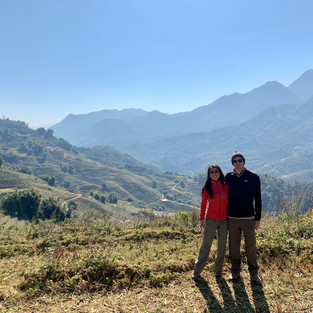The Hills Are Alive: Sapa, Vietnam
- tangio
- Feb 9, 2020
- 8 min read

The villages of Sapa unfold in layers over time, both physically and culturally.
Stepping into its iconic rice terraces, built over multiple generations of hill tribe families, we saw these stunning contoured layers of green earth stretch from our feet all the way toward the horizon. The expansive view made us laugh at the first question we had posed to a hill tribe homestay company, when we were initially unsure of whether to visit Sapa in mid-December (when all the rice had already been harvested and thus, we ignorantly feared, the views may be gone): “Will we still get to see rice terraces at that time?”
The answer is a resounding yes, you can’t miss the rice terraces in Sapa, as they are everywhere! And it turns out that the villages of Sapa are breathtakingly beautiful any time of year, whether in the heat of planting season or in cold winter mornings.

It was interesting to enter Vietnam—a country known for its crazy bustling cities boasting phenomenal international food and motorbike traffic jams—and then go up to rural Sapa first, tucked into the northwest mountains of the country and mostly populated by the highland hill tribes of the Black Hmong and Red Dzao, among others, all of whom originate from China and who speak their own distinct languages. But, we were on a mission to fit in Sapa before meeting some friends in Hanoi, so upon landing in Vietnam, we immediately hopped onto one of the country’s infamous overnight buses (the first of many!), which conveniently picked us up from the Hanoi airport on its way up north.
After a curvy-but-bearable bus ride in long sleeper seats, we landed in Sapa at 3:30am; they let us continue to sleep on the parked bus until the slightly more reasonable hour of 6:00am, at which point, everyone was kicked out into the bitter cold of the Sapa morning. High up in the mountains (the tallest peak in the country, Mt. Fansipan, is nearby, measuring 3,143 m/10,312 ft), Sapa really does get cold, and not just “Southeast Asia cold.” We braved the 35˚F morning and found our way to Sapa O’Chau, the social enterprise that educates, trains, and employs local hill tribe populations in sustainable tours and guesthouses that we had chosen for our guide and homestay.
At 9:30am, we met Sai, our 24-year-old Hmong guide dressed in colorful traditional clothing, who led us through 15 km/9.3 mi of steady, comfortable hiking on the first day. We snaked through the villages of Y Lin Ho and Lao Chai on tiny dirt footpaths that form the perimeters of thousands of rice paddies, allowing villagers to climb the hillsides with ease. Each rice field is individually owned by the local families, passed down through generations, who tend to them on their own and who grow the rice mostly for their own consumption, with occasional surplus for sale. From a distance, the rice terraces look like the grandest work of art you will ever see, meticulously sculpted and carved into the earth in magnificent designs harmonious with the mountainside. Up close, the brilliance of the farming infrastructure is revealed, as gravity-fed waterways can be eased open or closed, flooding each rice paddy as needed. As mentioned above, rice is harvested in the fall and thus was already gone by the time we were there in December, but many of the paddies were still flooded with water during the off-season; this way, Sai told us, the soil is kept soft and the water buffalo can go in to graze and rest, its heavy stomping essentially acting as a natural tiller, preparing the land for planting season come April.

Walking alongside Sai also provided us an insightful window into the everyday life of the villages and hill tribes. She was married at 16 years old and has never left the region; the town of Sapa, with a population of about 62,000 people, is the largest place she’s ever visited. Sai has two kids, the youngest of whom we got to meet when we were done hiking for the day, since we stayed in her village of Lau Chai. She told us that if a man did not have a son with his first wife, he often takes on a second wife to try to produce male progeny. She didn’t get to go to school, since “back in her day” (she is only 24!), only the boys in her village went to school. Today, fortunately, all kids go to school, and we were lucky enough to visit an elementary school in Sai’s village, where we verified that, indeed, both girls and boys were there (performing their morning exercises to “Head Shoulders Knees and Toes!”). Sai couldn’t read due to her lack of formal education, which surprised us because her English is near perfect and her worldliness impressive. She had learned all her English from working with tourists in her job as a tour guide, and expressed that many other local women did, too.
We noticed this. Almost all the tour guides across Sapa were women, and the homestay businesses in the villages were also primarily run by the woman of the house. They were often the ones to speak English, while the men could not. This likely stemmed from the fact that men used to work in the agricultural fields for longer hours (though we still saw many women in the fields, herding buffalo), leaving the women as the ones to take advantage of the tourism industry when it started to take off in Sapa. They were the ones who went through professional job-training, picked up English, and built their homes into dual-purpose guesthouses, bringing in significantly more income. This was interesting to observe, given that the boys were the ones historically sent to school and that men are still considered the head of the family. When we asked Sai about his, she laughed and joked that the men often just sat around drinking “happy water” (their term for locally made moonshine).
This trend was not just isolated to Sapa. We noticed that all across Vietnam, the women were the ones doing the work—in the cities, the women ran the food carts, rose early to cook breakfasts in the restaurants or homestays, and were our main points of business contact for nearly every single guesthouse, bus, and tour reservation that we made. This did not free them from household duties; we also saw the women doing all the cooking, child pick-up, and laundry (their own family’s, as well as ours!), often with a newborn baby on their hip and a wide smile on their faces. As a result, we saw many infants and toddlers running around local shops and restaurants, likely because the women worked double duty as lead parent and head of the family business. The men, by very noticeable contrast, often spent the day sitting or sleeping on their motorbikes in the streets, waiting for the next customer or Grab booking (Southeast Asia’s Uber), which was often few and far in between. And that was if they were working at all. We saw many men passing the hot days drinking endless cases of beer in local restaurants. Once, we were out enjoying a late breakfast at 10:30am in Danang and were surrounded by multiple tables of local men socializing loudly, having already downed at least 30 cans of beer, which lay empty around them. We saw the same drinking circles morning, afternoon, and night, and women were never around, other than as servers and cooks in these restaurants. Of course, these are grand generalizations—and to be fair, we did experience some excellent and hard-working Vietnamese men as tour guides and drivers—but these trends were commonplace enough throughout our month in the country that it feels safe to say that Vietnam, like so many other places, truly runs on the backs of its amazing, industrious, and entrepreneurial women.

Back in Sapa, we met another one of these superwoman as our Hmong homestay host, Mae. Not surprisingly, Mae’s English was superb, as she had been a tour guide for nine years. In fact, she was the first one to build out some guest beds in her home as part of Sapa O’Chau’s homestay program, nearly a decade ago. We arrived in Mae’s home just before sunset after our first day of hiking. Her own home, where she lives with her husband and five kids, is a traditional village home, with large rooms and scant furniture, featuring concrete floors, cinder block walls, and a tin roof with occasional holes in it. An open back doorway by the kitchen leads out to a farmyard. Dishes are washed in a large plastic tub and water is heated over an open fire inside the house. Mae’s guesthouse annex, which is connected to her home and housed six guest rooms, is constructed of mostly single-panel wooden walls and floors. Neither her home nor the guesthouse had insulation or heat, so we were quite cold throughout the night and in the morning as temperatures dipped down into the 30s F again. Luckily, we were the only guests there this late in the hiking season, so we were able to horde six blankets each! Meanwhile, the home is outfitted with satellites that bring in TV and WiFi so they could watch YouTube in their living room. It is fascinating to us that it is more important to be connected to the world than to have heat, but such is the case these days!

We spent our night with Mae mostly eating and drinking on small bamboo stools around the open fire, which seems appropriate, considering that the Hmong do not have a word for “hello,” but rather, greet people with, “Have you eaten yet?” In fact, we saw them eat a large dinner twice—once at about 4:30pm when some distant relatives stopped by, and then again at about 7:00pm when they cooked a ridiculous meal for the two of us. We ate rice that they had grown themselves, some of the best fresh spring rolls we’ve ever had, and way too much other greens, chicken, and pork. Over homemade “happy water” that they had brewed themselves, we toasted each other and watched funny YouTube videos of (non-Hmong) Americans speaking and singing in Hmong, which Mae was very proud to share.
What we loved most about this homestay and Sapa overall, is how communal their lifestyles are. Everyone knows each other in these villages, and people’s kids and animals just come and go as they please. We met several of Mae’s siblings and their families, since people just stopped by unannounced and stayed for awhile. At one point, there were four dogs roaming around us in the kitchen, to which Mae explained, “This one is my dog, that one is my sister’s dog, these other two, I don’t know.” But in the Hmong way, they fed them anyway.
After bidding farewell to Mae and her family the next morning, we spent the day hiking another 12 km / 7.5 mi through the villages of Ta Van and Giang Ta Chai before heading back to Sapa town. As a nice contrast to the first day, this second day was filled with more village life than rice fields. We passed village homes with “pet buffalo” pens and duck and chicken farms. We walked under large swaths of freshly dyed cloth hung out to dry in the sun, dripping dark indigo stains on the ground below them. (Fun fact: the indigo plant looks just like a basil plant, at least to our unknowing eyes, and they grow all over Sapa.) We sidestepped children racing each other up and down waterfall rocks, while older teenage girls hiked out baskets of bamboo on their backs, bringing the multi-purpose material back to their homes. We watched in awe as entire families hauled and placed large boulders into the hillside, building new fishponds for their village. On the narrowest of paths that we could barely walk on, we dodged motorbikes that would suddenly race by, on their way home to a house seemingly in the middle of nowhere.
Everywhere we passed in Sapa, life was happening, vibrantly and almost unexpectedly, in the space between rice paddies and small towns, between tradition and modernity; even if just for a brief couple days, we were grateful to be part of the unique heartbeat that resounds throughout the beautiful layered hills of Sapa.
Karen & Michael
Sapa, Vietnam, December 10-11, 2019























































Comments